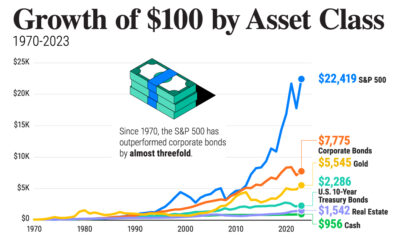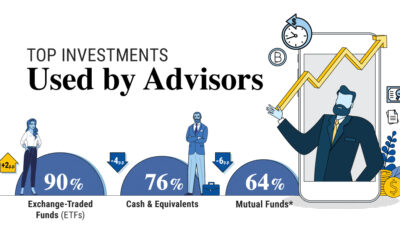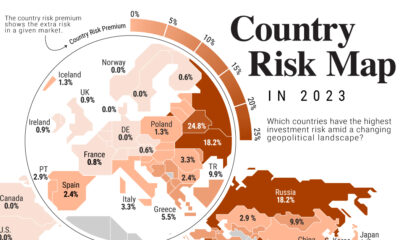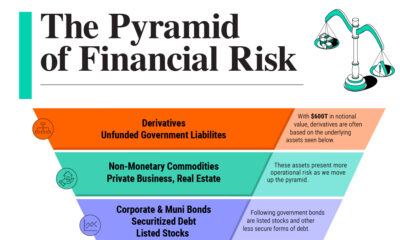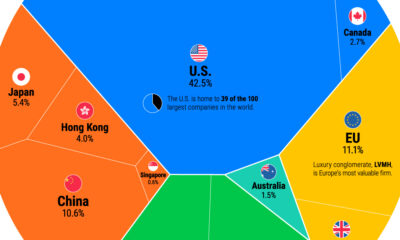This infographic is available as a poster.
Asset Class Correlation Over 25 Years
How can you minimize the impact of a market crash on your portfolio? One main strategy is building a portfolio with asset classes that have low or negative correlation.
However, the correlation between asset classes can change depending on macroeconomic factors. In this Markets in a Minute from New York Life Investments, we show the correlation of select asset classes and how they have shifted over time.
What is Correlation?
Correlation measures how closely the price movement of two asset classes are related. For example, consider asset class A and B.
- If asset class A rises 10% and asset class B also rises 10%, they have a perfect positive correlation of 1.
- If asset class A rises 10% and asset class B doesn’t move at all, they have no correlation.
- If asset class A drops 10% and asset class B rises 10%, they have a perfect negative correlation of -1.
When investors are building a portfolio, asset classes with negative correlation or no correlation are most desirable. This is because if one asset class drops during a market downturn, the other asset class will either rise or be unaffected.
Correlation Between Stock Categories
Stock categories have historically had some level of positive correlation. Here are the correlations for small and large cap stocks, as well as developed and emerging market stocks.
| U.S. Small Cap vs. U.S. Large Cap Stocks | Developed vs. Emerging Market Stocks |
| 1996 | 0.64 | 0.51 |
| 1997 | 0.63 | 0.76 |
| 1998 | 0.97 | 0.87 |
| 1999 | 0.58 | 0.80 |
| 2000 | 0.38 | 0.74 |
| 2001 | 0.87 | 0.78 |
| 2002 | 0.73 | 0.90 |
| 2003 | 0.85 | 0.75 |
| 2004 | 0.83 | 0.79 |
| 2005 | 0.93 | 0.93 |
| 2006 | 0.75 | 0.93 |
| 2007 | 0.89 | 0.75 |
| 2008 | 0.96 | 0.95 |
| 2009 | 0.91 | 0.88 |
| 2010 | 0.96 | 0.97 |
| 2011 | 0.97 | 0.89 |
| 2012 | 0.91 | 0.89 |
| 2013 | 0.86 | 0.86 |
| 2014 | 0.75 | 0.78 |
| 2015 | 0.82 | 0.76 |
| 2016 | 0.89 | 0.73 |
| 2017 | 0.39 | 0.14 |
| 2018 | 0.88 | 0.73 |
| 2019 | 0.94 | 0.91 |
| 2020 | 0.93 | 0.89 |
| Min | 0.38 | 0.14 |
| Max | 0.97 | 0.97 |
Rolling 1-year correlations based on monthly returns.
When macroeconomic conditions are strong, the correlation between stock categories tends to be lower as investors focus on individual company prospects. However, when market volatility rises, stocks tend to become more correlated as investors move to safer assets.
This was the case in 1998, when small and large cap stocks reached a peak correlation of 0.97. Russia defaulted on its debt, and a highly-leveraged hedge fund called Long Term Capital Management (LTCM) faced its own defaults as a result. Many banks and pension funds were invested in LTCM, and the Federal Reserve bailed out the fund to avoid a bigger crisis.
Shortly thereafter, small and large cap stock correlation reached a low in 2000. The dotcom bubble initially burst among large cap stocks, impacting some of the world’s largest companies. Small cap stocks didn’t see losses until 2002.
For developed and emerging markets, correlation peaked in 2010 when many countries were recovering from the global financial crisis. On the other end of the scale, correlation plummeted to its lowest level in 2017. One reason is that emerging markets became more distinct from one another due to their varying political risk and sector makeup.
Bonds, Commodities, and Currencies
In contrast to stock categories, there are some asset class pairings that have provided a low or negative correlation. Here is historical correlation data for U.S. stocks and bonds, as well as gold and the U.S. dollar.
| U.S. Stocks vs. U.S. Bonds | Gold vs. U.S. Dollar |
| 1996 | 0.51 | 0.29 |
| 1997 | 0.68 | -0.40 |
| 1998 | -0.41 | -0.19 |
| 1999 | 0.34 | -0.36 |
| 2000 | 0.40 | -0.44 |
| 2001 | -0.39 | -0.38 |
| 2002 | -0.72 | -0.30 |
| 2003 | -0.04 | -0.43 |
| 2004 | 0.04 | -0.65 |
| 2005 | -0.20 | -0.27 |
| 2006 | 0.28 | -0.86 |
| 2007 | -0.44 | -0.55 |
| 2008 | 0.34 | -0.67 |
| 2009 | 0.64 | -0.33 |
| 2010 | -0.58 | 0.29 |
| 2011 | -0.35 | -0.59 |
| 2012 | -0.37 | -0.53 |
| 2013 | 0.33 | -0.11 |
| 2014 | 0.24 | -0.60 |
| 2015 | -0.26 | -0.10 |
| 2016 | -0.21 | -0.58 |
| 2017 | -0.09 | -0.23 |
| 2018 | -0.26 | -0.51 |
| 2019 | -0.37 | -0.51 |
| 2020 | 0.29 | -0.43 |
| Min | -0.72 | -0.86 |
| Max | 0.68 | 0.29 |
Rolling 1-year correlations based on monthly returns.
Stocks and bonds generally have low correlation, with negative correlation in 14 of the last 25 years. Correlation tends to be highest during periods of high inflation expectations. On the flip side, correlation is typically lower during periods of low inflation expectations or high stock market volatility.
These factors contributed to negative correlation in 1998 during the Asian Financial Crisis. Stock prices flattened due to company trade relationships with Asian economies, while bonds benefited from lower rates and lower inflation. In 2002, high market volatility due to the dotcom bubble resulted in stocks and bonds reaching their most negative correlation.
Similarly, gold and the U.S. dollar generally move in opposite directions, with negative correlation in 23 of the last 25 years. When optimism in the U.S. economy is high, the U.S. dollar tends to rise. Conversely, when there are concerns about the U.S. economy or inflation, gold is considered a safe asset that holds its value.
In 2006, gold and the U.S. dollar reached their most negative correlation. As the beginnings of the subprime mortgage crisis appeared, investors piled into safe haven assets such as gold. In 2010, gold and the US dollar had a brief moment of positive correlation. Concerned about the European debt crisis, investors sought safe haven assets elsewhere, including both gold and the U.S. dollar.
Choosing Asset Classes
As investors think about which asset classes to include in their portfolios, it’s important to consider correlation. For instance, stock categories have historically been positively correlated. To diversify, investors may want to consider bonds and alternative assets such as gold.
In addition, macroeconomic events such as financial crises can have an impact on correlation, and investors may want to monitor these changes over time. Finally, considering the risk and return characteristics of various asset classes will allow investors to build a portfolio best suited to their needs.




 Infographics2 years ago
Infographics2 years ago
 Markets in a Minute2 years ago
Markets in a Minute2 years ago
 Markets in a Minute2 years ago
Markets in a Minute2 years ago
 Infographics2 years ago
Infographics2 years ago
 Markets in a Minute1 year ago
Markets in a Minute1 year ago
 Markets in a Minute2 years ago
Markets in a Minute2 years ago
 Infographics1 year ago
Infographics1 year ago
 Markets in a Minute2 years ago
Markets in a Minute2 years ago

